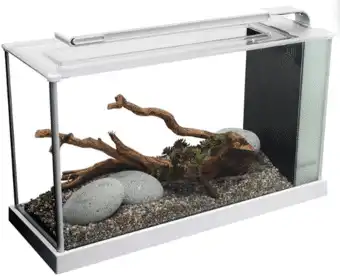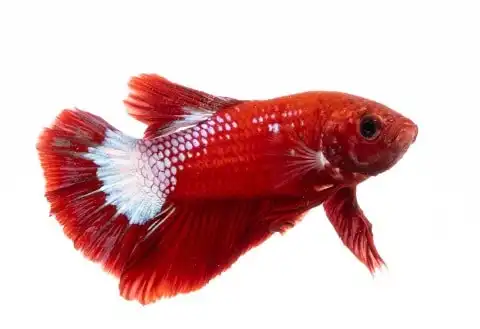Thank you for visiting! By the way… any links on this page that lead to products on Amazon and other stores/partners are affiliate links Aquarium Store Depot earns a commission if you make a purchase.
Are you ready to take a plunge into the amazing realm of veiltail betta fish? These mesmerizing creatures are famous for their glorious colors and unique fins that billow like a bridal veil. To ensure your Betta fish can thrive, it’s essential to give them proper care and attention. We will help you provide an ideal home environment with this post, which covers the characteristics, behavior, & requirements of these pretty aquarium fish!
Let’s get started on our journey as we learn how to keep veiltail bettas happy in their new abode!
Key Takeaways
- Veiltail bettas are beautiful fish with long, flowing tails that come in many vibrant colors and can live up to 5 years and grow to 3 inches.
- Like all bettas, they should be kept in adequate spaces, with 5 gallons being the best size for a solo fish
- To create a suitable habitat for veiltail bettas, replicate their native environment of slow-moving or still waters with warm temperatures & almond leaves help maintain a healthy environment.
- Bettas are insect eaters and need insect matter and high protein diets. Food like Fluval Bug bites are excellent for them
- When choosing tank mates be sure to pick nonaggressive fish. Proper care and monitoring is essential for the health of your veiltail betta.
Species Overview
| Scientific Name | Betta splendens |
| Common Names | Veiltail Betta Fish, Siamese Fighting Fish |
| Family | Osphronemidae |
| Origin | Thailand (Southeast Asia) |
| Diet | Omnivore |
| Care Level | Intermediate |
| Activity | Slow to Moderate |
| Lifespan | 2 – 5 years |
| Temperament | Peaceful (Aggressive to own kind) |
| Tank Level | Middle to top |
| Minimum Tank Size | 5 gallon |
| Water Temperature Range | 76°-81°F |
| Water Hardness | 5 to 20 DH |
| pH Range | 6.5 – 8.0 (for most varieties) |
| Filtration/Water Flow | Low |
| Water Type | Freshwater |
| Breeding | Egg-layer |
| Difficulty to Breed | Easy to breed |
| Compatibility | Community fish (when with other species) |
| OK, for Planted Tanks? | Yes |
Understanding Them
Betta splendens, otherwise known as Veiltail bettas or Fancy Bettas, are a popular variety of Siamese Fighting Fish widely recognized for their captivating coloring and long flowing fins. When these beautiful creatures are generally easy to care for in an aquarium, they must be given proper care to ensure their long term health. It is the most common type of betta you will come across in stores and is usually very affordable.
A deeper understanding about where this type of fighting fish originated from can also aid us in caring for them better. Let’s dive into their background further to learn where they came from.
Origins And Habitant
Veiltail bettas are a Southeast Asian species found in countries like Thailand, Cambodia, Indonesia and Vietnam. They populate rice paddies in the wild and were originally kept by locals to breed to fight in betting competitions.
These Siamese Fighting Fish require calm waters with hardly any current for optimal growth, exactly as it is in their natural habitat. To replicate this environment at home when setting up the tank, avoiding too much flow and maintaining an appropriate temperature range should be given top priority. This will ensure the healthy development of veiltail bettas over time.
The Fighting Formula
Thailand’s secret, when it came to fighting betta fish, was in the use of almond leaves. The introduction of almond leaves to a betta tank is incredibly beneficial for veiltail bettas. You can help maintain strong and healthy fish by treating water quality through the release of tannins that lower pH levels, thereby creating an ideal environment for these species1.
The presence of antifungal and antibacterial agents in this natural resource serves as a mild disinfectant within tanks, which toughens the scales & skin of the fish, making them stronger competitors when it comes to fighting diseases or illnesses. Altogether, adding almond leaves to your aquarium will provide significant benefits to keep your finned friends happy & active!
Appearance
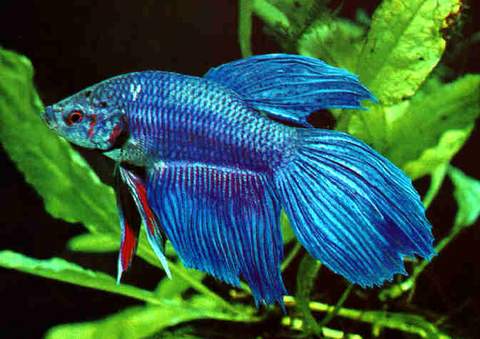
The veiltail bettas are admired by many due to their long, flowing tails that dangle from the fins. Their magnificence is especially seen in the variety of colors they possess, such as royal blue, turquoise, emerald green, fire engine red, and orange, along with bright yellow and near purple for those looking for something different. The male fish boast spectacular colorings and elongated tails versus female fish that are more plain and have shorter fins.
It’s very important when taking care of your precious veiltail betta to watch out for any signs or changes in coloration which might hint at stress levels being too high, or there might be underlying health issues requiring medical attention quickly if you hope to provide a healthy life environment.
Size
Veiltail bettas typically range from 3.8 – 7.6 cm (1.5 – 3 inches) in length, with the males usually being larger than females of this type of fish species. They are the usual size compared to other betta fish species. You may be able to find a giant subtype breed, but most giant types are created from other variants, not the Veiltail. Giants can grow up to 5 inches in length.
Lifespan
Caring for veiltail bettas correctly can extend their lives to a span of anywhere from two up to five years or even longer. Establishing and maintaining the ideal environment, providing them with balanced meals, and routinely performing tank maintenance are all key elements in ensuring they remain healthy, which is essential for prolonging the friendship you’ll have with your beautiful fish.
Behavior And Temperament
Veiltail bettas are a popular choice for aquarium pets due to their peaceful and calm personalities. They can become aggressive when around other male veiltails in particular. To ensure your tank environment is stress-free, it’s important to select suitable non-aggressive species as companions (more on this later in the post). This helps reduce any potential aggression between fish and encourages harmony among the inhabitants of your aquarium so that everyone remains healthy and happy.
Veiltail Betta Care
To ensure a healthy and comfortable living space for your veiltail betta, proper care requires creating an appropriate tank setup with suitable decorations as well as controlling the vital water parameters. These details will play a major role in keeping them healthy and contented.
The following sections explain how to construct their home properly, pick out adequate furnishings, and regulate essential environmental conditions – all of which are necessary elements for providing the best environment possible for your beloved veiltail betta fish!
Some advice on how to accommodate them with other fish includes providing plenty of cover such as plants which will create distinct territories lessening any aggression. Keeping male bettas separate from each other so fights don’t occur and selecting tankmates that have similar water temperature requirements along with pH levels. Finally, monitoring all activity carefully around the tank, especially if signs suggesting belligerent behavior start arising between two species living alongside one another.
Tank Setup And Size
Having its own tank is essential in providing a comfortable and stress-free environment for your veiltail bettas. This allows them to show off their beautiful colors and fascinating behavior, as well as preserve good health. When setting up the aquarium, it must have at least 4-5 gallons of capacity. Adding a heater will allow you to maintain an ideal temperature between 75°F – 81°F since these species are tropical fish by nature. Also include gentle filtration with slow flow rates that simulate natural conditions being experienced by the veiltail betta wild counterparts.
The Best Betta Fish Tank
Best filtration, best light, perfect size and with everything you need to get started. It was made for Bettas!
Important Tank Conditions (Parameters)
Note while Betta fish do have a labyrinth organ to survive in low oxygen environments, it will still be stressed in poor water. Keep track of these parameters below and consider making a water change if they exceed any of these recommended levels:
Decorations
For your veiltail betta’s tank, make sure to pick out gentle decorations that don’t harm its vulnerable fins. Providing suitable objects can encourage natural behavior and improve the health of your fish by offering stimulating activities – think logs, living or silk fake plants, as well as almond leaves. Creating a pleasant atmosphere for them is key!
These leaves can be added to your aquarium to help promote a natural habitat for bettas, shrimp, and other soft-water loving fish. Betta breeders can use these leaves to help encourage breeding behavior.
Important Water Parameters
In order to keep your veiltail betta healthy, it is critical that the water parameters remain within certain ranges. The ideal temperature should be between 75-81°F, with a pH level of 6.8-7.5 and general hardness at 5-20 GH. Regular testing can ensure any potential issues are identified promptly so they can be resolved quickly for a safe habitat environment for your fish friend! Monitoring these settings will help you make sure everything stays perfect in this corner of their universe!
Feeding
A varied diet is essential for veiltail bettas to get the right amount of nutrients. Feed them twice a day with betta pellets, live food like blood worms and brine shrimp or frozen versions of these foods, as well as insect larvae such as daphnia. Keep in mind not to overfeed since this can lead to several health concerns later on down the line. A carefully balanced meal will help keep your fish happy and healthy overall.
Choosing Tank Mates for Your Veiltail Betta
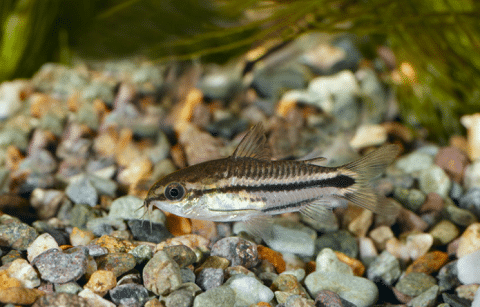
When selecting tank mates for your veiltail betta, it is important to consider the fish’s temperament and choose suitable companions. The following are all great non aggressive options, as they will help create a peaceful atmosphere in the aquarium:
These are just several possibilities for a tank mate. I have a better list in our best betta tank mates post.
Male bettas often regard these types of fish with hostility. Picking compatible tank mates such as those mentioned before can provide an overall stress free habitat ideal for all your aquatic friends, including your beloved veiltail betta!
Bad Tank Mates
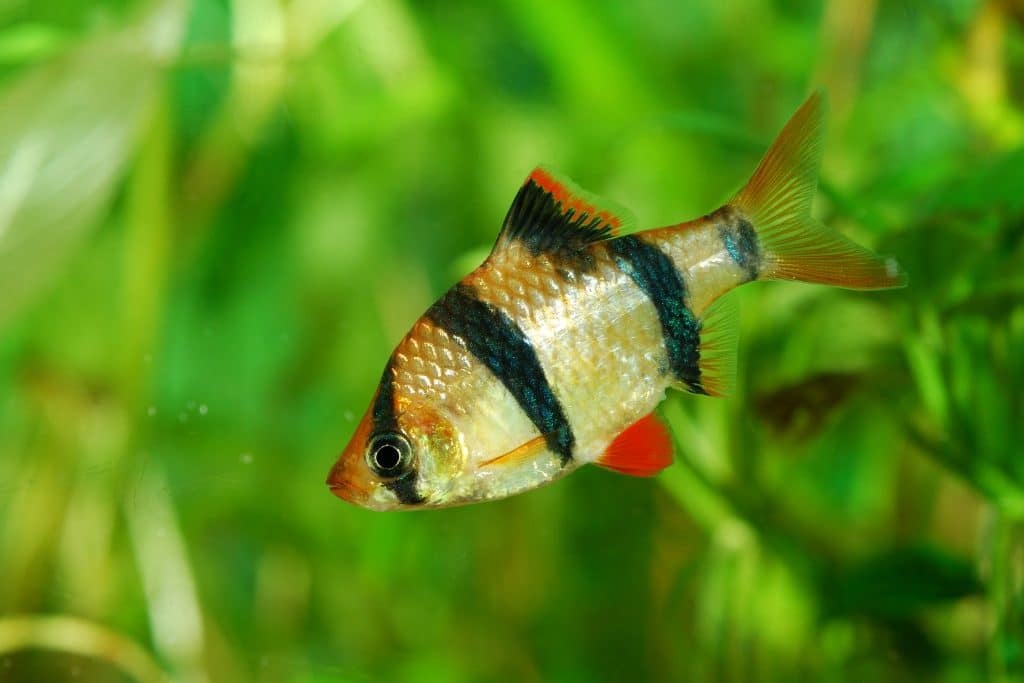
To ensure peace within the tank environment, steer away from brightly colored or long finned species. After that, avoid these other species as your betta will be bullied or eaten by them:
- Tiger barbs
- Cichlids
- Angelfish
- Goldfish
- Nippy tetras like black skirts
Breeding
If you’re keen on breeding veiltail bettas, a separate tank should be installed in order to guarantee the safety and comfort of the mating pair. Bubble nests are a key component needed for breeding to occur. The male needs to first build its bubble nest then will attract a female. When she lays her eggs, it is up to the male veiltail betta to guard them and put them into his built bubble nest. To save those little ones from being eaten remove the male once the eggs hatch. The female should be removed once mating occurs, as the male will chase away the female from the nest.
For the successful raising of fry after they hatch out, we must provide an appropriate food supply and consider foods such as infusoria and baby brine shrimp until the fish are big enough to move onto regular foods.
Common Health Issues
Veiltail bettas are known to be hardy. Certain ailments can arise if proper care is not observed. Fin and tail rot, columnaris (mouth fungus), as well as fin rot are the main culprits. Other major diseases like vertical death hang also occur. Cleanliness in their tank environment with correct water parameters and an appropriate diet should work wonders when it comes to avoiding these possible health issues.
Monitoring for any suspicious changes in behavior or physical appearance of your veiltail betta is essential. A healthy fish that looks cheerful will brighten up any aquarium! I have a full post on common betta fish diseases that you can read up on.
Purchasing
Find these betta fish is easy as they are very common in virtually any pet store you visit. However, because they are so common, they can also be sold in poor conditions. If you want a rarer variety, visit a specialized local pet store or consider visiting an online merchant.
Use Coupon Code ASDFISH at Checkout
Betta Fish are one of the most beautiful varieties of freshwater fish available in the hobby. Easy to care for with plenty of varieties!
When looking at your potential betta pet, look out for the following:
- White spots
- Torn up fins
- Heavy breathing
- Obvious loss of colors
Also, note that specialized fish stores will usually not put bettas in tiny containers but will have them in separated out tanks. These are better conditions for them to sell as the water can be filtered, and the fish can be monitored better at the store. My recommendation would be to purchase bettas from a store that sells these fish in separate tanks versus tiny containers, as there is a better chance for you to find a healthy specimen.
Frequently Asked Questions
Are veiltail bettas aggressive?
Veiltail bettas have a relatively low level of aggressiveness, making them favored among those who like to own betta fish. Although they are territorial and can be hostile to other creatures in the tank, they are less aggressive than other types of betta fish.
What is the lifespan of a female veiltail betta fish?
A female veiltail betta fish can live for a maximum of five to seven years if it is provided with adequate care, which includes feeding them properly and keeping the tank clean. The typical lifespan tends to be 2-4 years. By making sure that your veiltail betta gets everything they need, you are increasing their chances of living longer and healthier lives.
How big do veiltail fish get?
Veiltail fancy goldfish can measure between 2-3 inches in length. There are sometimes giant varieties available that could grow as large as 5 inches in length.
Which betta is more aggressive?
Plakat bettas, bred for combat and known to be notably hostile due to their temperamental traits, are the most aggressive variety of Bettas. They exhibit more aggress tendencies compared with other breeds.
How can I tell if my veiltail betta is stressed or sick?
Monitoring the color and swimming behavior of your veiltail betta is important, as any changes in either can be signs that they are stressed or unwell. Heavily breathing and unhealthy looking fins are other signs to watch out for.
Closing Thoughts
To sum up, veiltail bettas are remarkable creatures sound should be appreciated like any other betta fish breed. Through investigating their origin, habitat needs, behavior and care requirements, we can make sure they have an ideal home environment for them to prosper in. With the correct maintenance of a proper diet and set up your betta will provide you with moments filled with its special beauty as well as amazing behaviors.
Have you kept this Betta before? If so, let us know in the comments below. We would love to learn more about your experiences with them. Until next time fish keepers!
- About the Author
- Latest Posts
I’m thrilled that you found Aquarium Store Depot! Here you’ll find information on fish, aquariums, and all things aquatics related. I’m a hobbyist (being doing this since I was 11) and here to help other hobbyists thrive with their aquariums! I adhere to a high quality Editorial Process and Review products with real life field usage and practical analysis.


